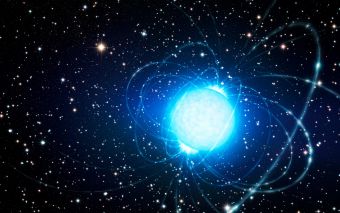 Astronomers who study cosmic explosions have a running joke: anything too wild to explain with standard models are probably magnetars. These scapegoats are neutron stars with extremely powerful magnetic fields, like the one shown to the right.
Astronomers who study cosmic explosions have a running joke: anything too wild to explain with standard models are probably magnetars. These scapegoats are neutron stars with extremely powerful magnetic fields, like the one shown to the right.
Super-luminous supernovae? Probably a magnetar collapsing. Short, weak gamma ray bursts? Why not magnetar flares. Ultra-long gamma ray bursts? Gotta be magnetars. Magnetars are a popular model due to their natural versatility. In today’s paper, the authors tie together several magnetar theories into a cohesive theoretical explanation of two types of transients, or short cosmic events: super-luminous supernovae (SLSNe) and ultra-long gamma ray bursts (ULGRBs).
Read the full review on Astrobites

